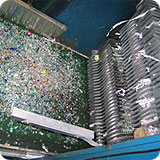 |
|
|
|
 |
|
 |
| |
| The protection of intellectual
property rights (IPR) continued to be high on the agenda
of the department. Under the sustained and vigorous enforcement
actions taken by the Intellectual Property Investigation
Bureau (IPIB) and the Special Task Force (STF), copyright
piracy and trade mark counterfeiting activities at all
levels remained under control in 2004 and significant
results were achieved. |
|
|
 |
|
 |
 |
|
 |
| |
| Anti-Piracy Enforcement:
Retail Sales
4. In the past two years, the department
continued to take strict enforcement actions against
retail outlets of pirated ODs and reaped significant
achievements. Under vigorous Customs enforcement actions,
the piracy situation in Hong Kong remained under control.
Pirates could only adopt stealthy modus operandi, such
as through "self-service" at unmanned stalls
and "pre-order sale" (i.e. customers pay
first at the shops and collect the discs later at other
locations by presenting their receipts) to sell small
quantities of discs. Besides, these illicit outlets
could only operate at short and irregular hours displaying
a minimum quantity of ODs on the premises to minimize
loss.
5. To counter the involvement of young
people in street-level peddling of pirated ODs, the
department also put extra effort on public education.
Apart from the IPR awareness programmes in school and
community, information pamphlets were distributed to
students before the commencement of school summer holidays.
The effectiveness of these measures was proved by a
significant drop in the number of youngsters under the
age of 16 arrested for IPR offences – from 162
in 2002 to 18 in 2004, representing a decrease of 89
per cent.
6. Besides, the Customs and the Social
Welfare Department (SWD) have jointly implemented a
referral scheme since April 2002, whereby young IPR
offenders who need counselling and other appropriate
welfare services will be referred to the SWD for follow-up
actions. The feedback of the scheme has been positive,
and the two departments will continue to co-operate
on this front to help young people to keep off piracy. |
 |
 |
 |
 |
 |
 |
 Customs officers continued to take strict
enforcement actions against retail outlets
of pirated optical discs.
Customs officers continued to take strict
enforcement actions against retail outlets
of pirated optical discs. |
|
 |
 |
 |
 |
|
 |
 |
 |
 |
 Forfeited
pirated optical discs were delivered to heavy
duty shredding machine for destruction. Forfeited
pirated optical discs were delivered to heavy
duty shredding machine for destruction. |
|
 |
 |
 |
 |
|

|
 |
 |
 |
 |
 Forfeited
pirated optical discs were shredded into small
pieces. Forfeited
pirated optical discs were shredded into small
pieces. |
|
 |
 |
 |
 |
|
 |
|
|
 |
|
 |
 |
|
 |
| |
| Anti-Piracy Enforcement
: Manufacture and Import & Export
7. Since the enactment of the Prevention
of Copyright Piracy Ordinance in May 1998, all
local OD factories have to obtain a manufacturer licence
issued by the department and are subject to Customs’
inspection. To further combat copyright piracy, the
Prevention of Copyright Piracy Ordinance (Amendment
of Schedule 1) Order 2002 came into effect on 19
July 2002, requiring manufacturers of stampers in Hong
Kong to obtain a licence as well. In 2003 and 2004,
Customs officers carried out 329 and 321 inspections
respectively to licensed factories to detect and deter
the manufacture of pirated ODs and stampers.
8. At the manufacture level, the sustained
efforts of the department against copyright piracy syndicates
have effectively driven all underground large-scale
production plants out of Hong Kong. Pirates have now
turned to operate limited-scale workshops using computers
and CD-writers to replicate pirated ODs inside small
industrial or domestic premises to evade Customs detection.
In 2003 and 2004 respectively, the department successfully
smashed 28 and 22 replicating workshops of this kind
with the seizure of 503 and 675 CD and DVD writers and
241 000 and 322 000 pirated ODs worth $6.08 million
and $8.87 million respectively.
|
| |
 |
|
|
 |
|
 |
 |
|
 |
| |
| Restraint of copyright
piracy proceeds
9. The department achieved a significant
breakthrough in copyright piracy enforcement in 2004
by applying the Organized and Serious Crimes Ordinance
(OSCO) to restrain copyright piracy proceeds. In July
2004, the department rooted out after one year of intensive
investigation a major local pirated optical disc syndicate.
A Restraint Order was successfully applied under the
OSCO to freeze suspected copyright piracy proceeds of
$18 million. This was the first time for suspected crime
proceeds to be restrained under the OSCO in relation
to copyright piracy offences.
|
|
|
 |
|
 |
 |
|
 |
| |
 |
 |
 |
 |
 A
workshop manufacturing counterfeit clothing
raided by the Customs. A
workshop manufacturing counterfeit clothing
raided by the Customs. |
|
 |
 |
 |
 |
|

|

|
 |
 |
 |
 |
 Counterfeit
clothes seized in an operation. Counterfeit
clothes seized in an operation. |
|
 |
 |
 |
 |
|
|
|
 |
|
 |
|
|

